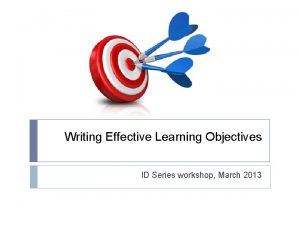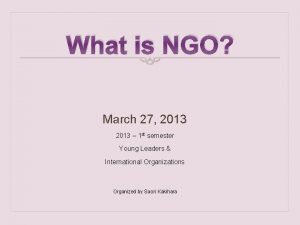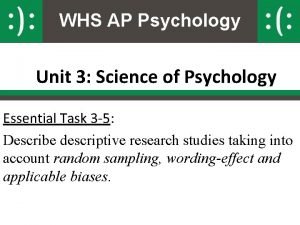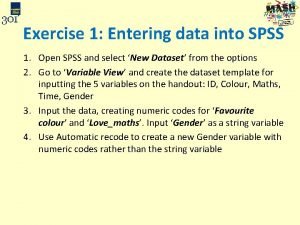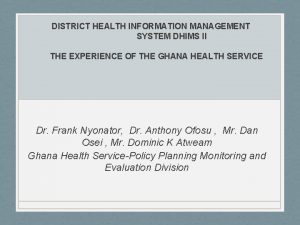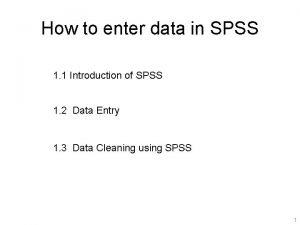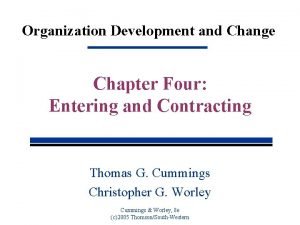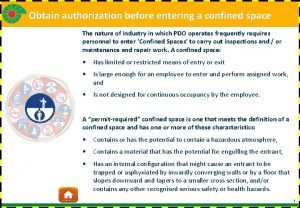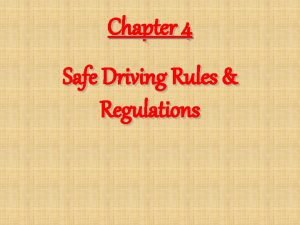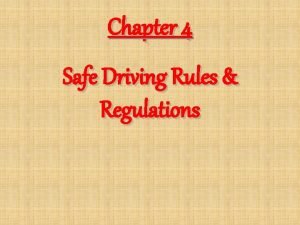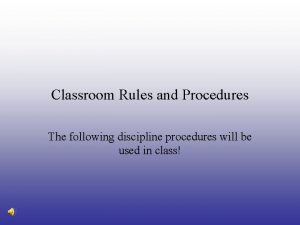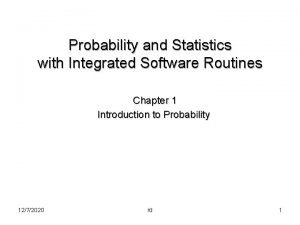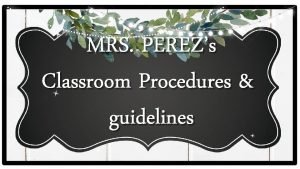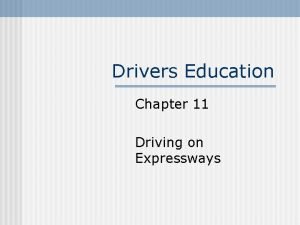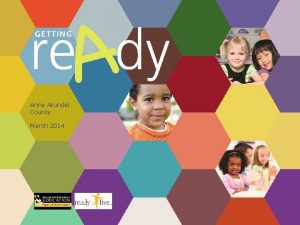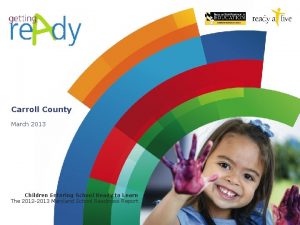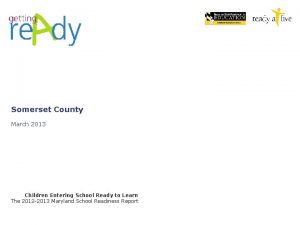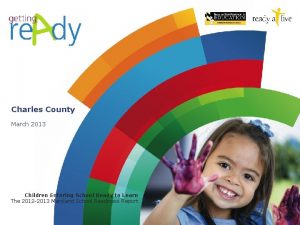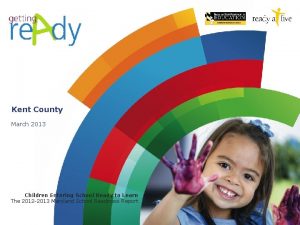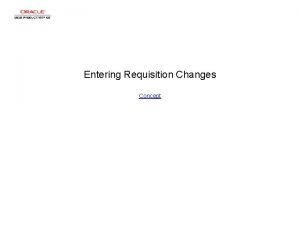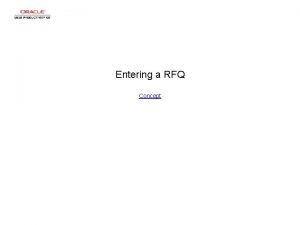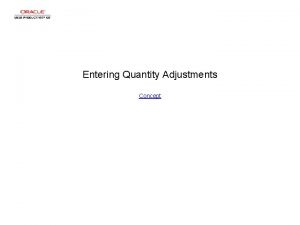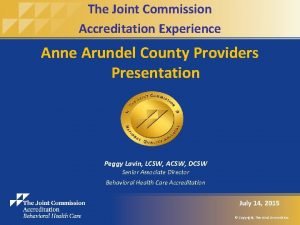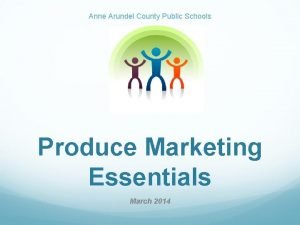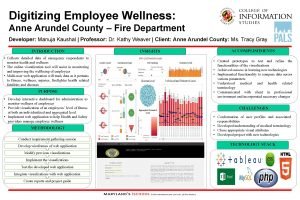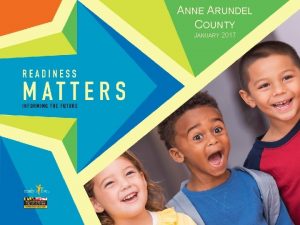Anne Arundel County March 2013 Children Entering School



























- Slides: 27

Anne Arundel County March 2013 Children Entering School Ready to Learn The 2012 -2013 Maryland School Readiness Report

The Early Years Impact of School Readiness • A child’s ability to successfully do kindergarten work. A Powerful Impact • School Readiness is one of the most important factors for educational and life success. • Investments in high-quality early learning are the most costeffective of any educational investment, returning as high as 15 -17 percent on the investment each year.

How does Maryland Assess Readiness? Maryland Model for School Readiness (MMSR) An annual assessment on what each kindergartener knows and is able to do in the following areas or Domains of Learning: • Language & Literacy • Mathematical Thinking • Physical Development • Scientific Thinking • Social & Personal Development • Social Studies • The Arts

How does Maryland Assess Readiness? Maryland Model for School Readiness (MMSR) A kindergarten child is identified as: • Fully Ready Ø Consistently demonstrates the skills, behaviors, and abilities, which are needed to meet kindergarten expectations successfully. • Approaching Readiness Ø Inconsistently demonstrates the skills, behaviors, and abilities, which are needed to meet kindergarten expectations successfully and requires targeted instructional support in specific areas. • Developing Readiness Ø Does not demonstrate the skills, behaviors, and abilities, which are needed to meet kindergarten expectations and requires considerable instructional support in specific areas.

Statewide Highlights MMSR, 2012 -2013 Key Trends in Maryland • • Compelling Long-Term Gains • 82% of children entering kindergarten in school year 2012 -2013 are fully school-ready, up from 49% in 2001 -2002. This represents a 67% improvement in overall school readiness. • More kindergarteners are ready for school than ever before – an additional 1, 400 students are fully school-ready in 2012 -2013 compared with last year. Making Significant Strides • The upward trend from school year 2001 -02 is evident for all subgroups of children. • Children with academic risk-factors – children from low-income families, English Language Learners, and children with disabilities – exhibit overall higher school readiness.

Statewide Highlights, continued MMSR, 2012 -2013 Key Trends in Maryland, continued • Addressing the School-Readiness Gaps • 76% of kindergarteners from low-income households (as indicated by Free and Reduced Price Meal status) are fully school-ready in 2012 -2013, up from 34% in 2001 -2002. Ø The 42 -point increase from 2001 -2002 reduced the readiness gap between children from low-income households and their peers from 18 points to 11 points in 2012 -2013. • English Language Learners (ELL: children whose first language is not English) and children with disabilities made considerable overall progress (a 34 -point gain and a 27 -point gain from 2001 -2002, respectively). Ø Readiness for these children declined slightly since 2011 -2012, impacting the school-readiness gaps between these subgroups and their Maryland peers.

Anne Arundel County Demographics of Young Children

Advancing School Readiness MMSR, 2012 -2013 Full School Readiness Maryland Anne Arundel County 100 80 72 Percent 62 60 40 51 86 86 83 82 86% of Anne Arundel County’s kindergarten students are fully ready for school in 2012 -2013 – a stunning 35 -point school readiness gain from 2001 -2002. • Anne Arundel County’s kindergarteners outpace the statewide readiness level, currently at 82%. 68 58 49 20 0 01/02 • 04/05 Maryland 07/08 11/12 Anne Arundel County Source: Maryland State Department of Education 12/13

Striking Overall Improvements MMSR, 2012 -2013 Anne Arundel County School Readiness 100 86 80 86% of Anne Arundel County’s kindergarteners are fully ready for school, up from 51% in 2001 -2002 and on par with last year. • The County exhibits an overall upward trend – a 69% increase since 2001 -2002. • Fewer than 100 kindergarteners (2%) require considerable support to do kindergarten work. 86 72 62 Percent • 60 51 44 40 33 25 20 12 13 5 4 3 1 2 01/02 04/05 07/08 11/12 12/13 0 Full Approaching Developing Trendline Note: A “Trend Line” denotes the overall upward progression of the County’s full school readiness levels. Source: Maryland State Department of Education

High Readiness in Key Domains MMSR, 2012 -2013 Anne Arundel County Full School Readiness by Domain • 73 Language & Literacy 40 78 Mathematical Thinking 42 90 Physical Development 60 78 Scientific Thinking 22 Social & Personal Development 80 60 83 Social Studies 36 86 The Arts 48 0 20 40 12/13 Percent 11/12 60 01/02 Source: Maryland State Department of Education 80 100 Kindergarteners show high readiness levels in key Domains of Learning – the core areas that predict future academic success: • Language & Literacy (73% fully ready for 2012 -2013). • Mathematical Thinking (78% fully ready). • Scientific Thinking (78% fully ready).

Upward Trends for All Ethnicities MMSR, 2012 -2013 Anne Arundel County Full School Readiness by Ethnicity • 79% of Hispanic children are fully school-ready, up from 37% in 2001 -2002. This gain narrowed the readiness gap between Hispanic and white children to 10 points. 40 65 American Indian 40 86 Asian 47 79 Hispanic Two/More Races 82% of African-American children are fully school-ready in 2012 -2013. The 42 -point jump from 2001 -2002 is substantially higher than the County’s overall readiness gain. 82 African American Native Hawiian/Pacific Islander • 37 79 87 89 White 54 0 20 40 12/13 Percent 11/12 60 01/02 - Not Tracked Source: Maryland State Department of Education 80 100

Good Progress Among Males & Females MMSR, 2012 -2013 Anne Arundel County Full School Readiness by Gender • 90% of females are fully schoolready in 2012 -2013, up from 58% in 2001 -2002. • 82% of males are fully ready, a 38 -point gain from 2001 -2002. This gain lessened the gap between males and female from 14 to 8 points. 86 All 51 90 Female 58 82 Male 44 0 20 40 12/13 Percent 60 11/12 80 01/02 Source: Maryland State Department of Education 100

Gains Among Low-Income Children MMSR, 2012 -2013 Anne Arundel County Full School Readiness by Income Status 100 88 78% of children from low-income households (as indicated by Free and Reduced Price Meal status) are fully school-ready. • The readiness gap between children from low-income households and their mid-/highincome peers narrowed to 9 points in 2012 -2013. 87 77 80 79 65 60 • 78 52 50 40 55 36 20 0 01/02 04/05 07/08 11/12 Percent 12/13 13/14 Children from Low-Income Households Children from Mid- to High-Income Households Low-Income (Projected) Mid- to High-Income (Projected) Source: Maryland State Department of Education

Addressing the School-Readiness Gap MMSR, 2012 -2013 Anne Arundel County Demographics & Key Trends • Children from Low-Incomes Households Ø The 42 -point increase from 2001 -2002 reduced the schoolreadiness gap between children from low-income households and their mid- to high-income peers from 16 points to 9 points in 2012 -2013. Ø The narrowing of the readiness gap is projected to continue. Ø This trend is significant because of the rising number of kindergarteners who are from low-income households – a 15% one-year increase. Ø 18% of kindergarteners in 2012 -2013 (1, 100 children) are from low-income households.

More ELL are Fully School-Ready MMSR, 2012 -2013 • More English Language Learners (ELL: children whose first language is not English) are fully school-ready: 72% in 2012 -2013, up from 32% in 2001 -2002. • This gain reduced the readiness gap between ELL and their English -proficient peers from 19 points in 2001 -2002 to 15 points in 20112012. • The gain is significant because of the rising number of ELL kindergarteners (5% one-year change). Anne Arundel County Full School Readiness by English Status 100 80 87 73 72 11/12 12/13 73 63 Percent 87 60 51 40 40 47 32 20 0 01/02 04/05 07/08 13/14 ELL English Proficient ELL (Projected) English Proficient (Projected) Source: Maryland State Department of Education

Progress Among Children with Disabilities MMSR, 2012 -2013 Anne Arundel County Full School Readiness by Disability Status 100 88 88 59 58 • 58% of children receiving special education services through an Individualized Education Program (IEP) are fully schoolready in 2012 -2013 – a 15 -point jump from 2001 -2002. • The readiness gap for children with disabilities grew from 8 points in 2001 -2002 to 30 points in 2012 -2013. 74 80 Percent 64 60 40 51 43 37 41 20 0 01/02 04/05 07/08 11/12 12/13 13/14 Children w/Disabilities Children w/o Disabilities Children w/Disabilities (Projected) Children w/o Disabilities (Projected) Source: Maryland State Department of Education

Language & Literacy Readiness Essential MMSR, 2012 -2013 Anne Arundel County Full School Readiness by Language & Literacy • There is a direct correlation between Language & Literacy skills and overall school readiness. • Language & Literacy readiness is most closely linked to proficiency on the subsequent Maryland State Assessment (MSA) in Grade 3. 100 80 72 Percent 62 60 40 51 86 86 74 73 61 52 40 20 0 01/02 04/05 All Children 07/08 11/12 Language & Literacy Source: Maryland State Department of Education 12/13

Language & Literacy Readiness Gap MMSR, Summary of 2012 -2013 Results, School Years 2001/02 to 2004/05 Anne Arundel County Skills Gap Status Full Readiness in Language & Literacy by Subgroups 40 35 Percent 30 • In language & literacy, the skills gap for children from low-income households and ELL narrowed to 13 points and 27 points in 2012 -2013, respectively. • The increasing Language & Literacy school-readiness gap for children with disabilities remains a challenge. 37 32 32 27 25 19 20 13 15 10 5 0 English Lanague Learners 10/11 Gap Low Income 11/12 Gap Children with Disabilities 12/13 Gap Source: Maryland State Department of Education

Prior Care Enrollment Predominate Care Prior to Kindergarten Anne Arundel County Prior Care Enrollment of Kindergarteners School Year 2011 -2012 0, 7% • 15, 2% 23, 9% 9, 9% 2, 0% 20, 8% In 2012 -2013: • 1, 838 children are enrolled in Anne Arundel County’s Pre. K program. • 34% of Pre. K children participate in a full-day program. 26, 9% Child Care Center Family Child Care Head Start Home/Informal Care Non-public Nursery Pre. K Repeat K NOTE: Some prior care settings have enrollment criteria. For example, Head Start Centers and public Pre. K almost exclusively serve children from low-income households and children with disabilities—two subgroups that have consistently had significantly lower school readiness than Maryland kindergarteners as a whole, and are considered at risk. Source: Maryland State Department of Education 24% of the County’s children who are currently enrolled in kindergarten attended a public Pre. K program in 2011 -2012.

Early Learning Success MMSR, 2012 -2013 Anne Arundel County Full School Readiness by Prior Care Settings* • 90% of children enrolled in Child Care Centers the year prior to kindergarten are fully ready in 2012 -2013 – a 44 -point increase from 2001 -2002. • There was a 45 -point jump to 75% full readiness for children enrolled in Head Start the year prior to kindergarten. • These improvements are higher than the County’s overall readiness gains. 90 Child Care Center 46 80 Family Child Care 54 75 Head Start 30 83 Home/Informal Care 36 95 Non-public Nursery 67 83 Pre-Kindergarten 48 0 20 12/13 40 10/11 Percent 60 80 01/02 * MMSR Pre. K data for 2011 -2012 not available due to an AACPS system error. Source: Maryland State Department of Education 100

Pre. K Children Are Well-Prepared MMSR, 2012 -2013 Anne Arundel County Full School Readiness by Pre. K 86 All • 83% of kindergarteners previously enrolled in Pre. K are fully ready in 2012 -2013. • Children previously enrolled in Pre. K are within 3 points of the countywide readiness average (86% fully ready) and outperform their lowincome peers (78% fully ready). • Pre. K programs serve a high percentage of low-income children; based on these results, Pre. K can be considered an effective way to address the readiness gap. 51 78 Low-Income 36 83 Pre. K 48 0 20 12/13 40 60 Percent 10/11 80 100 01/02 * MMSR Pre. K data for 2011 -2012 not available due to an AACPS system error. Source: Maryland State Department of Education

Behind the Numbers Race to the Top Early Learning Challenge Maryland’s 33 -point school-readiness gains since 2001 -2002 affirm that we are clearly doing a number of things right. Race to the Top Early Learning Challenge (RTT-ELC) $50 million federal investment is supporting comprehensive infrastructure improvements in Maryland. Investments advance: • State (and local level) governance structures • High-quality, accountable programs • Access to high-quality, early learning and development programs • Early learning and development standards • Alignment of standards with early learning curricula, activities, assessments, and professional development • Comprehensive assessment systems • Intervention and prevention programs • Family engagement • The early childhood education workforce

Behind the Numbers Race to the Top Early Learning Challenge Maryland’s Benchmark: Race to the Top Early Learning Challenge Benchmarks 95 92 88 85 84 83 82 81 75 70 92% of kindergarteners fully school-ready by 2015. • While Maryland was on track to meet this goal, the 20122013 readiness levels (82% fully ready) fall slightly below our annual targets. 90 90 80 • 79 77 73 73 71 74 72 65 10/11 11/12 12/13 13/14 14/15 Maryland Benchmark Maryland Full Readiness Maryland L&L Benchmark Maryland L&L Full Readiness Source: Maryland State Department of Education 15/16

Behind the Numbers A Decade of Overall Progress Maryland’s RTT-ELC efforts are only some of the many investments that account for the overall gains. Our innovations, targeting young children birth to five, are key to our success: Building Infrastructure • Establishing a comprehensive, aligned, and highly-effective early care and education system. • Working with the 24 local Early Childhood Advisory Councils (ECAC). Improving Quality • Using MMSR data to drive school readiness strategies. • Aligning Pre. K and Kindergarten benchmarks with the Common Core. • Implementing new specialized curricula. • Promoting higher standards: Maryland Excellence in Early Learning Standards (Maryland EXCELS). • Accrediting more programs and credentialing additional professionals.

Behind the Numbers A Decade of Overall Progress Focusing on Academic Risk Factors • Enrolling children with one or more academic risk factors in statefunded Pre. K programs. • Launching 2 new satellite Judy Centers. Engaging Families and Communities • Helping families, and community members learn how to support children’s school readiness. • Utilizing a Coalition of Family Engagement to develop a family engagement framework. Supporting Healthy Beginnings • Promoting developmental screenings to ensure early detection of delays or disabilities. • Working with pediatricians to promote early literacy programs.

What’s Next? More Work to Do Nearly 12, 000 Maryland kindergarteners needed targeted or considerable support to be successful in school. To ensure that our children succeed in school and in life, we are: Striving to Meet New Benchmarks • Committed to achieving ambitious goal: 92% kindergarteners fully school-ready by 2015. Addressing the School-Readiness Gaps • Taking proactive measures to reduce readiness gaps among academically at-risk subgroups. Continuing & Enhancing Current Efforts • Supporting the ECACs, which are critical for helping to address the challenges and continue our momentum. • Exploring innovative early childhood investment strategies.

What’s Next? More Work to Do Creating a Strong Workforce • Promoting rigorous and developmentally appropriate instructional practices that support our Common Core Standards. • Credentialing and workforce competency standards will serve as the basis for a comprehensive early childhood education career ladder for skilled and dedicated personnel. Building Better Access • Improving access to Pre. K and other high-quality early learning programs. • Establishing Preschool For All Sites. • Improving case management for families receiving child-care subsidies to further improve access to Pre. K, Head Start, and quality child care.
 Anne arundel county fire stations list
Anne arundel county fire stations list Anne arundel crisis response
Anne arundel crisis response March march dabrowski
March march dabrowski March 2013
March 2013 What is ngo
What is ngo An arundel tomb genius
An arundel tomb genius Arundel partners the sequel project case solution
Arundel partners the sequel project case solution Arundel zamek
Arundel zamek The lost children of rockdale county
The lost children of rockdale county Cps lorain county
Cps lorain county Gonowufo
Gonowufo What can prevent arthropods from entering billets
What can prevent arthropods from entering billets Entering data into spss
Entering data into spss Dhims2
Dhims2 Entering data in spss
Entering data in spss Dua to enter house
Dua to enter house Don't ask me anything about sports. i like football
Don't ask me anything about sports. i like football Interpersonal process issues in entering and contracting
Interpersonal process issues in entering and contracting Obtain authorization before entering a confined space
Obtain authorization before entering a confined space Safe corridors law
Safe corridors law Chapter 4 safe driving rules and regulations
Chapter 4 safe driving rules and regulations Procedures for entering and exiting the classroom
Procedures for entering and exiting the classroom When entering foreign markets basic entry
When entering foreign markets basic entry Advance sunrise and delayed sunset is due to
Advance sunrise and delayed sunset is due to Entering foreign markets
Entering foreign markets Two dice are numbered 1 2 3 4 5 6 and 12 2334
Two dice are numbered 1 2 3 4 5 6 and 12 2334 Procedures for entering the classroom
Procedures for entering the classroom Drive right chapter 11
Drive right chapter 11



